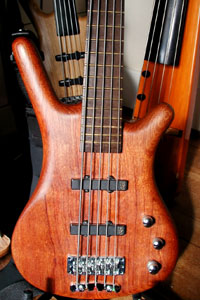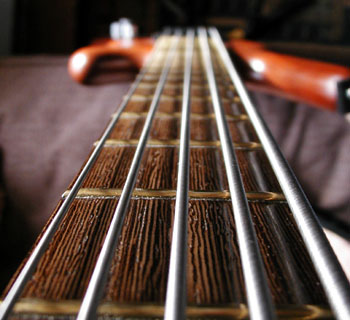If Eight Was Two
My main bass turned two today. Or eight, depending how you count. I took possession on the Leap Day that is the Exception to the Exception to the Leap Day Rule*, February 29, 2000. So I've been playing it eight years, but it just celebrated its second birthday.

Some five-stringers loiter menacingly
It's a Corvette Standard, made by Germany's Warwick, inheritors of the rather infamous Framus legacy. The specs have changed a bit since I got mine, but a Corvette is not particularly spectacular as electric basses go. Mine's got some nice features—five strings, defeatable active electronics—but the instrument doesn't sport some of the flash that's become de rigueur on many pro five-string basses today (35-inch scale, 18-volt electronics, 3-band onboard EQ, heaven-forbid light-up LEDs in the fingerboard, and so on.) And the dense hardwoods mean that despite the small body, it weighs in at around 11.5 pounds. That's more bass than many players are willing to handle.
When I first got the bass, I spent a fair bit of time shielding the electronics cavity (for some reason, it had a talent for pulling in AM radio). So it wasn't quite a dream on Day One. But the main reasons I got the bass were the flexibility of its tone, the range of adjustments it supports, and the amazing neck.
To a tinkerer, the two-piece Warwick bridge is a thing of beauty: if you imagine turning precision German engineering loose on Gibson's Tune-o-matic bridge, you get the idea. Users can adjust the height and tilt of the bridge, but also the front-to-back and side-to-side positioning of individual string saddles—and the range of adjustment is substantial. For folks who set up their basses once and leave'em that way forever, these aren't killer features. But for folks like me who are constantly experimenting with new strings and new setups—sometimes completely changing the bass's setup for a single recording gig—it's a big deal. Despite all the possible tweaks, the bridge has considerable mass and does a great job transferring vibration to the body. In other words, it doesn't sacrifice tone or sustain for adjustability.

Just look at the crap built up behind the frets…tsk tsk.
When I first got the bass, I had to tweak the truss rod to get the neck relief—the amount of bow in the fingerboard—set correctly. But here's the thing: in eight years, that's the only time I've had to mess with the neck. Warwicks take a lot of heat for their heavy laminate necks: the weight impacts the balance of the instruments, with some five- and six-string models being famously prone to "neck dive" (where, when played using a strap, the necks drop toward the floor unless the player constantly holds it up). I've hauled this bass all over the U.S., down into Mexico, and across Canada in the winter. I've strung it with flatwounds, groundwounds, half-rounds, taperwounds, and some of the heaviest stainless steel strings I can find. Every new kind of strings means setting the intonation again at the nut and bridge…but neither changes in strings, temperature, humidity, season, latitude nor longitude have made me have to mess with the neck. I appreciate that. I'm also a big fan of the neck's narrower string spacing: it's about 8.5mm between strings up at the nut, closer to the so-called Jazz spacing (named for the four-string Finder Jazz bass), which makes it easier to play.
Tonally, the bass has been good to me as a session player: the electronics offer a surprisingly wide dynamic range, it can get the full "Warwick growl," and can hold the fundamental on sustained notes rather than gliding off into harmonics. It can also cover a broad range of Fender Precision and Jazz bass tones (what I call the "Fender farts"), put down a mean funk line, and dial back nicely for classic rock, blues, and country. My one complaint with the bass's tone might be that it's often too bright: I usually have to dial it back at the amp or with the onboard pre-amp. However, brightness is one of those odd things in bass tone: if you have it, you can always get rid of it, but if you don't have it, you can't create it by fiddling with EQ or other settings. So better to have it than not. I also have an allergy to nickel, so I usually run stainless steel strings—and they're brighter than their nickel counterparts. So I'm happy to dial back a bit at the amp. And I sometimes think about replacing a couple of the side position makers: a few of mine are rather dark abalone, and can be hard to see on stage under shifting or dimming lights.
I don't intend this to be some sort of love letter to Warwick. Although I've encountered Warwick basses in all kinds of bands, they seem to position themselves as a bass maker for hard rock players, and I've never cared for the playability of their well-known "Thumb" basses (which, I've gotta admit, have a great funk tone) or some of their more recent designs and variations. Recently the company rolled out a less-pricey, consumer-friendly RockBass line: these are based on Warwick designs and are built in China using cheaper parts and woods like rosewood, alder, and maple in place things like bubinga and ovangkol. I've played a few, and…well, I've played crappier basses and they aren't horrible, although one I played was mis-wired at the factory. That's about as much as I want to say.
Anyway—I'm wishing my bass a happy birthday. Don'tcha go gettin' old on me.
* The Rule of Leap Years: to make up for the fact that Earth's solar (or tropical) year is 365.24 days, years that are evenly divisible by four get an extra day, tacked on as February 29…but that would mean the calendar would drift ahead of the seasons by a full day every 400 years. So, to keep that from happening, if a given year is evenly divisible by four and is also a century year, it doesn't get an extra day. So, back in 1900, 1800, and 1700, there was no February 29. (Never mind that back in 1700 the western world was still converting between the Julian and Gregorian calendars, so calendar drift was a much larger problem.) This is all well and good, but it creates a system that drops behind the seasons by a quarter day ever 400 years. So, there's another exception to the exception: if a century year is also evenly divisible by 400, it does have a leap day o February 29. So, February 29, 2000 is an example of the rarest of all Leap Days. The next one will be February 29, 2400. I'll probably be playing a different bass by then.
- Categories:
- Tunings & Twangings
Hey, what's life without fine print?
